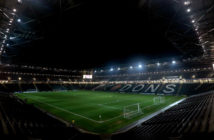
The empty seats of Sydney FC following the publication of a list of fans banned from attending domestic matches from all teams. (Source: Sydney Morning Herald)
It has been a rough couple of weeks leading into December for Australian football. The already shaky relations between the supporter bases and the League were tested again on the back of news that the Football Federation Australia (FFA) has been keeping a list of supporters from all of the 10 domestic clubs who have been issued with bans from stadiums and grounds. It is not startling that there would be a group of people who have been removed from the grounds or been excluded from games. The main complaint has been the fact that this ‘list of shame’ was kept secret combined with the fact that no one on the list could challenge the ban was what caused supporter groups across the league to question the legality of it.
The 40 page document that was leaked included the names of 198 individuals who are banned from the grounds due to incidents ranging from the lighting of flares to serious assault cases against grounds security staff and opposing fans over the past three years. Though no club has a clean record of fan culture according to the document, a staggering 50% of the banned come from the supporter groups associated with the Western Sydney Wanderers or incidents at the Sydney Derby.
The FFA have hit back saying that they are not the only fans being targeted. Rugby League has a grand total of 19 banned fans across sixteen teams, with even fewer fans banned from cricket. For those of you who are not too familiar with the cricket schedule it is in the summer and boring, the only thing to do is drink. How more people have not been banned from the cricket grounds actually baffles me.
Soccer in Australia has long been speculated on as being haven of hooligans who hide behind their team colours. Sydney ‘shock jock’ Alan Jones even went so far as to compare the fan violence to the recent terrorist acts witnessed in Paris. While many supporters and part time spectators of the league have been vocal about not wanting to see the barricades that away fans sit behind in some of the European Leagues, there has been more call for this by stadium security and the law enforcement community.

An area of the stands usually populated with the Mariners’ core supporter base is seen almost empty with a sign indicating the fans have “gone to the pub”, during the round 9 A-League match between the Central Coast Mariners and Melbourne City FC at Central Coast Stadium in Gosford, on Thursday, Dec. 3, 2015. (AAP Image/Dan Himbrechts)
After the leak, all major supporter groups across the ten teams lifted banners in solidarity for to those who could not enjoy the atmosphere from inside the stadium and point out heavy handed tactics from the FFA and police. The Australian police force are mainly ‘white’ while soccer fans tend to be a large mix of the world. In Australia the majority are ‘wogs’ ( people of Mediterranean descent being classified as ‘non-white’). While there are people of both communities who are both fans of the game and officers of the law, most times it seems that the lines that are drawn are the blue officers and the fans entering the stadium. Though it is not right, and I far from agree with violence directed at police or opposing fans, I am forced to explain how many people view the mounted officers that flank them as they enter for home games, much less away games. With this in mind, supporters have long felt they were subject to unfair police policies, toeing a line of not being protected enough when they are away fans, and being micro managed as home fans.

Melbourne Victory fans show their support for 198 fans from all clubs who have been banned from attendance (source: Sydney Morning Herald)
To drive home their point, supporters from Melbourne Victory and the Western Sydney Wanderers staged separate walk outs during the first half of their respective matches to re-enforce their displeasure. The FFA took notice. Nearly 30 fans from all ten clubs came together for a round-table discussion with former Socceroo and current Fox Sports commentator, Mark Bosnich and FFA chief executive David Gallop were also in attendance to try and find a solution to what has been labelled “the worst problem in Australian sport.”
At the end of the discussions fans of the beautiful game in Australia walked away with a victory in the face of the Football Federation Australia and the domestic A-League. Current and potentially future fans who face a ban will be notified of it with an appeal process to be put into practice which will allow the individual to view the evidence put against them and the potential of being cleared of the ban. This was announced just before the first match of the weekend, with all games going ahead as scheduled and thankfully with fans and supporters once again in attendance and devoid of any major incidents.
![Prost International [PINT]](https://prostinternational.com/wp-content/uploads/2021/08/PINTtFontLogoRoboto1536x78.jpg)


